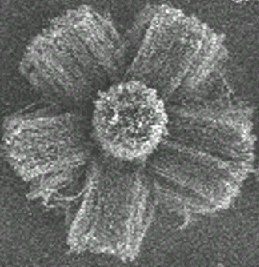3-D nanotubes grown
April 5, 2002 | Source: KurzweilAI
Researchers at Rensselaer Polytechnic Institute have grown the first three-dimensional nanotubes, which are essential for next-generation computer chips and integrated circuits.

3-D nanotubes
Nanotubes have properties that make them attractive as active nanoscale electronic components, such as transistors, sensors, and interconnecting wires.
“Because of the small size of nanotubes, a large number of them can be packed in a given space and will enable very high (e.g., factor of 10 to 100 greater than possible with conventional materials and technologies) device-density processors and memory-storage modules that are presently not possible with currently available technologies,” Ganapathiraman Ramanath, assistant professor of materials science told KurzweilAI.net.
“In order to create such device assemblies, however, one needs to first controllably create assemblies of nanotubes in well defined orientations. For example, if we want nanotubes to interconnect devices placed at two locations A and B on a silicon wafer, we need to devise a process that will force the nanotube to grow from A towards B and terminate at B.
“Also, one needs to be able to do this in millions of locations on a silicon wafer all at once (bottom-up approach) to create a device assembly (placing one nanotube at a time after creating them will not be industrially scalable).
“Until now, people have been able to achieve only random growth of nanotubes, or oriented nanotubes in one direction. Our work is the first demonstration wherein we can force the nanotube to grow at specific locations in any predetermined directions we want them to grow and in a single deposition process.
“The impact of our work is well beyond nanotubes. This is the first step toward making complex networks comprised of molecular units. By manipulating the topography of the silica blocks, and utilizing the selective and directional growth process, we have been able to force nanotubes to grow in predetermined, multiple directions, with a very fine degree of control.”
The researchers used gas phase delivery of a metal catalyst, essential for nanotube growth, to make their growth process more flexible and more easily scalable than conventional methods.
Their research is reported in the April 4 issue of the journal Nature.
